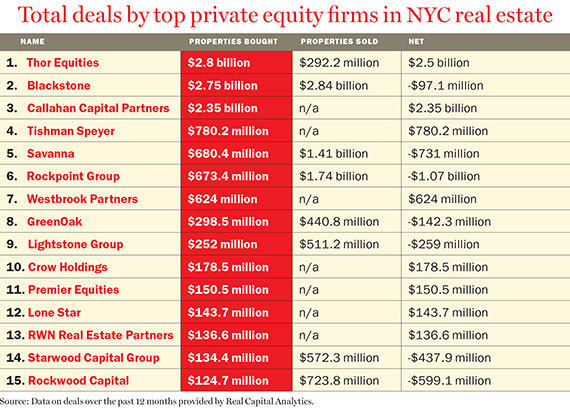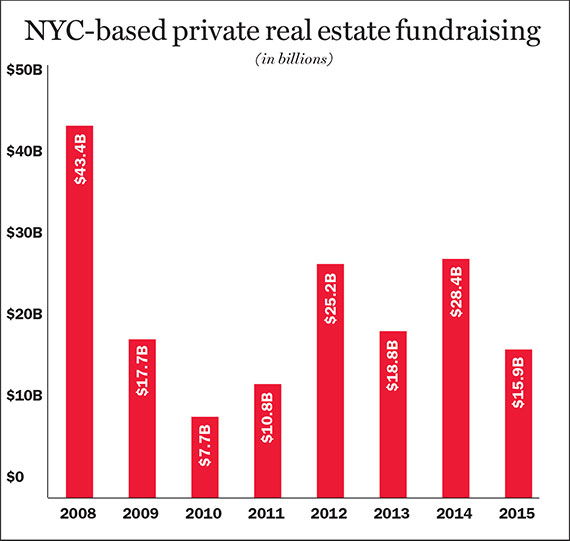With competition for New York City real estate fiercer than ever, real estate-focused private equity funds are coming up with new strategies to pump up returns.
To be sure, even with money pouring in from new rivals like foreign billionaires and sovereign wealth funds, private equity has held its own when it comes to buying trophy buildings and investing in luxury development properties.
In fact, all private equity funds — which we defined as non-public funds that pool money to invest in real estate, but are not classified as REITs — threw down more than $13 billion on New York properties in the last 12 months alone.
“I think that we’re seeing them pursuing deals as aggressively as ever,” said Joe Berko, head of the real estate brokerage Berko & Associates, who has arranged several deals for private funds.
This month, using data from Real Capital Analytics, The Real Deal ranked the top 15 private equity funds by the amount they’ve invested in the New York City market in the last 12 months. Some firms, such as Tishman Speyer and Lightstone Group, are developers that also act as equity funds, and are therefore included in the ranking.
Of the total, the three largest funds, Thor Equities, Blackstone Group and Callahan Capital Properties, have invested more than $2 billion apiece in New York properties since last April.

While the 15 funds have diverse backgrounds, they collectively have a growing sense that times have changed in the New York City investment market.
“The overwhelming view is that there is more competition, which makes it harder to find attractive opportunities than it was a year ago,” said Andrew Moylan, head of real estate asset products at Preqin, a research firm that tracks private funds.
As they search for returns, a number of funds are modifying their strategies.
In the years following the financial crisis, private funds such as Blackstone, Rockpoint Group and Savanna were among the few players with money to spend. While banks and insurers were still righting their balance sheets, these funds bought up trophy properties in Manhattan at depressed prices.
Then, when the tsunami of overseas and institutional money began sweeping over Manhattan, driving up prices, these firms netted massive profits. In one high-profile example, Savanna sold the Twitter headquarters, at 245-249 West 17th Street, last summer to American Realty Capital’s New York REIT for $335 million, more than four times the $75.8 million it paid for the property in late 2012.
New frontiers
While the market boom initially boosted profits, it has also made it harder to re-invest them.
Buying a Manhattan skyscraper and selling it a few years later no longer guarantees the hefty returns funds have pledged to their investors. As a result, they have begun pursuing new types of deals.
“Alternative debt is becoming a conversation, and funds are doing more co-sponsorships,” said Berko.
Barry Sternlicht’s Starwood Capital, which invested $134.4 million in New York real estate last year and just raised $5.6 billion for a new fund, is among those branching out. The fund has partnered with Michael Stern’s JDS Development and Kevin Maloney’s Property Markets Group on a number of luxury developments. And last year, a Starwood fund gave World-Wide Group a $450 million construction loan for its condo development at 250 East 57th Street.
In New York, there’s also a noticeable shift in the types of properties funds are investing in.
“A lot of private equity funds are getting more nervous,” said Garrett Thelander, executive managing director of capital services at Cushman & Wakefield, who works on deals with private equity funds. “They were doing a lot of condo and hotel projects, but because of where we are in the cycle, they are more cautious now.”
Some funds have begun shifting their focus to new markets — or are more heavily investing in areas that they’ve only tested in the past, including the outer boroughs. For example, Thor Equities, a retail-focused firm that’s invested in Brooklyn in the past, recently added another investment in the borough to its roster. The firm, which according to TRD’s ranking spent more in New York City in the last 12 months than any other private equity firm, shelled out $36.1 million for a 3,600-square-foot development site at 180 Bedford Avenue in Williamsburg. And the Lightstone Group, an investment and development firm that also acts as an equity fund, is constructing a 700-unit rental building at 363 Bond Street in Gowanus.

There are, of course, still plenty of funds going after Manhattan trophy properties. In January, the Chicago-based Callahan Capital Partners teamed up with the Canadian real estate investment and development firm Ivanhoé Cambridge on the $2.2 billion purchase of 3 Bryant Park. That deal helped to catapult Callahan to the No. 3 spot on the ranking.
And there were other trophy purchasers. Blackstone dished out $605 million for the office tower 1740 Broadway last year, while Tishman Speyer plans to develop a $3.2 billion office tower in Hudson Yards.
Money to spend
Private funds have continued to invest in New York City despite the growing competition in part because they simply have so much money available.
With bond yields at historic lows, institutional investors like insurance firms and pension funds are increasingly looking at private real estate funds to invest in.
“What we’ve seen in terms of fundraising is a reflection of institutional appetite for real estate,” said Preqin’s Moylan.
And the fundraising numbers bear that out. New York–based private real estate funds reached a post-crisis peak of $28.4 billion in 2014 and are on track to top that total this year.
In the first quarter of 2015, only four funds raised money. But they hauled in $15.9 billion.
Blackstone dominates among New York–based real estate fund managers. Its real estate funds have raised $68.1 billion dollars since 2008. That’s around 40 percent of the total raised by all funds.
Between December and March alone, Blackstone reportedly raised $14.5 billion for a new real estate fund, and indications are some of its money may end up in the Big Apple.
At a conference last month in Manhattan on the REIT industry, the head of Blackstone’s real estate group, Jonathan Gray, echoed caution over hotel and condo development.
But he also argued that changes in the global economy will continue to drive up real estate prices. “We’re definitely bullish on New York City and London,” he said.